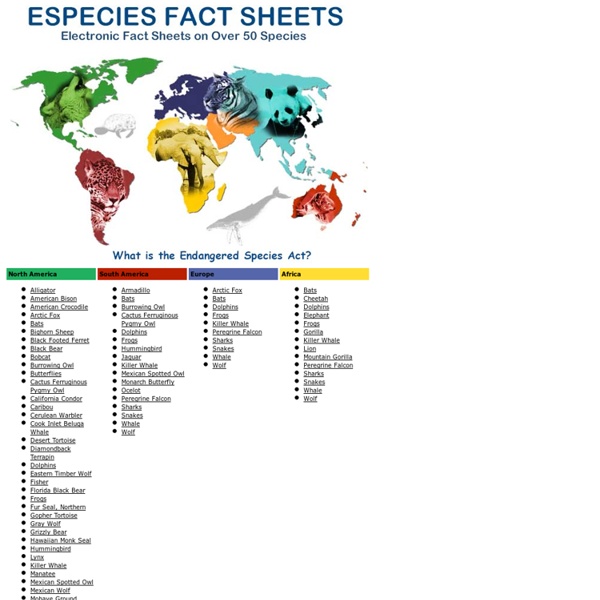



http://www.kidsplanet.org/factsheets/map.html
Animals As of July 1, 2013 ThinkQuest has been discontinued. We would like to thank everyone for being a part of the ThinkQuest global community: Students - For your limitless creativity and innovation, which inspires us all. Create Easybib Account Instructions One account. All of Google. Sign in to continue to Docs
Animal Bytes One Page Fact Sheets Each byte is a one-page fact sheet specifically designed to help you quickly find information about some of the interesting creatures found in the animal kingdom. Most species files include coverage regarding scientific classification, basic physical traits, fun facts, and conservation/ecological value. Where available, links to more in-depth species coverage via our online infobooks are provided.
Animals The Animal Kingdom The animal kingdom is huge. It contains more than a million species. Most are small - much smaller than your eyes can see. Food Chain - Kid's Corner The Food Chain Every living thing needs energy in order to live. Everytime animals do something (run, jump) they use energy to do so. Animals get energy from the food they eat, and all living things get energy from food. Plants use sunlight, water and nutrients to get energy (in a process called photosynthesis). Energy is necessary for living beings to grow.
Animal Facts and Information at Animal Corner The animals that inhabit our planet are all amazing creatures. Each have their own behaviours and life cycles that continue to create fascinating animal, bird, reptile and insect life. Discover the mammals that nurture their young as we humans do, insects that go through the process of metamorphosis, an amazing transformation of egg, larvae and pupae. Our dinosaur relatives, the reptiles, lay eggs, just like birds. Take a look at Animal Corners animal kingdom. Please note, all animals featured on this site are not listed on this.
American Deserts The prickly pear is a cactus with wide, flat stems called cladodes. It is defended by long, sharp spines. Ground squirrel Ground squirrel Teach the Children Well-Animals AdaptationAdaptations to A Desert BiomeAnimal AdaptationsAnimal Adaptations and SurvivalAnimal Adaptations GameAnimal Adaptations E-SafarisAnimal CamouflageAnimal DiversityAnimals and AdaptationAnimals, Adaptation and the Galápagos IslandsThe Body ChangersBuild a BeastCamouflageDirtmeister's Animal AdaptationsEvolutionHot or ColdHow Animals Meet Their NeedsHow Plants and Animals Survive the WinterMimicryPenguin AdaptationUnderstand Wildlife Winter Survival StrategiesWacky Animal DefencesWhat Do Animals Do in Winter?What Does Adaptation Mean?Wildlife in Winter--Adaptations for SurvivalWinter Adaptations of Animals Amazing Bats of Bracken CaveBat Conservation InternationalBats!Bats Are CoolBats at Enchanted LearningBats in AustraliaBatty About BatsBat WorldBouncing SoundsChiropteraEcholocation VideoEcho the BatHow to Build a Bat HouseIs That A Lark I Hear?
Nature Files 1. Adaptation a. Evolution 2. Coloration a. Deceptive Coloration b. Camoflauge in Animals Mimicry Some animals and plants look like other things -- they mimic them. Mimicry is another type of deceptive coloration. It can protect the mimic from predators or hide the mimic from prey. If mimicry was a play, there would be three characters. Rainforest Animals